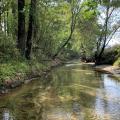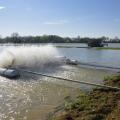pH and Alkalinity
Just like many gardens in Mississippi, some ponds can benefit from the occasional addition of agricultural limestone. This is true for ponds that have an alkalinity less than 20 ppm. Ponds with low alkalinity are unproductive, even when sufficient nutrients are in the water either naturally or because the pond is fertilized. Fertilizing a pond with alkalinity less than 20 ppm is a waste of time and money.
What is alkalinity?
Alkalinity is the measure of the buffering capacity of the water. It is essentially a measure of the major negative ions dissolved in the water, especially carbonate and bicarbonate. These come from dissolving rocks within the watershed, particularly limestone. Conversely, the positive major ions (calcium, magnesium) make up the hardness of water and come from the same rocks. The balance between dissolved carbon dioxide and the buffering capacity determines pH.

In waters with low alkalinity, pH might fluctuate from 6 or lower to as high as 10 or above every day, which can make fish sick or grow slowly. Alkalinity is related to hardness, so soft water (low hardness) usually has low alkalinity.
What is the recommended alkalinity?
For fish production and health, alkalinity of at least 20 ppm is recommended. Greater production in bass-bluegill ponds is attained in high alkalinity waters because this buffering capacity makes phosphorus and other essential nutrients more available to the plankton.
Fish are stressed by extremes in pH and rapid changes in pH and tend to grow more slowly and be more susceptible to illness when alkalinity is low. After oxygen, poor water chemistry is the next-most common cause of fish kills in ponds. When alkalinity is very low, stressed fish may die during weather changes and rain events, with a few fish of all species dying each day.
A pH value between 6.5 and 9.0 is optimum for fish ponds. Alkalinity testing kits are widely available at many pool and spa stores and at county agricultural co-ops. These test kits are easy to use. Also, most county MSU Extension offices or NRCS Service Centers can test water alkalinity.
What if alkalinity is less than 20 ppm?
For ponds with alkalinity less than 20 ppm, pond health can be substantially improved by increasing alkalinity. The most common method of increasing alkalinity in waters is by adding agricultural limestone (calcium carbonate).

Adding lime to these ponds elevates alkalinity and increases pH in the water. Neutralization of bottom soil with lime prevents phosphate from adhering to it, thereby increasing phosphorus concentrations in the water (the primary nutrient in ponds). As a result of these changes in water quality, phytoplankton blooms develop, and pH fluctuates less.
If a pond has a high rate of water flow in and out, liming may not be a solution. Such a pond has a low water retention time, and the lime washes out quickly.
Soil Testing
If you are building a new pond, have the MSU Extension Soil Testing Laboratory test the soil to determine how much lime is needed before filling the pond. Soil sample boxes, instructions, and information sheets are available at your county Extension office. Read more on how to take, submit, and interpret soil samples.
Pond Soil Testing
If pond is larger than 3 acres, partition the pond into 3-acre blocks, and sample each block separately. Collect about a pint of soil from each of 10 locations per block. If the pond is fewer than 3 acres, collect three samples per acre. Thoroughly mix the samples together in a bucket. Take one sample from the mixture and air-dry.
Place this sample in a soil sample box and submit to the Soil Testing Lab at Mississippi State University. Be sure to indicate in the “crop grown?” window on the submission form that this sample is for a farm pond (Code 50).
Repeat this procedure for each 3-acre block in the pond. The sample will be analyzed, and you will receive a report indicating if your pond needs lime and how much to apply. Important note: This liming recommendation will need to be adjusted based on the agricultural limestone available in your area.

To collect a soil sample from a pond containing water, use a tin can nailed perpendicular on a long stick (depends on pond depth) or a long PVC pipe to collect bottom mud. Use an S-shaped pattern to collect samples as described above.
Ponds in the Delta generally do not need additional lime, and ponds in the Black Belt and thick and thin loess soils need only small amounts. Ponds in the red clay hills of north and central Mississippi usually need 2 tons of lime per acre, and the sandy soils of South Mississippi usually need 2 to 3 tons of lime per acre.

Liming Agents
Only agricultural limestone should be used for existing ponds with fish populations. This is the same form of lime farmers use on their crop and pasture land. You can buy it in bulk or bag form. Never use quicklime, hydrated lime, slaked lime, builder’s lime, or other more potent liming agents! These other forms are different chemical compounds that are very caustic and may kill fish.
When to Apply
It is best to lime the pond in fall or winter at least 2 months before the growing season. Liming a pond in the spring increases pH, removes soluble phosphorus, and reduces free carbon dioxide. This affects the productivity of the pond. If you lime the pond in the fall or winter, it has time to equilibrate before the growing season.
Lime Application
It is easiest to apply lime when the pond is dry. For the lime to be effective, spread it evenly over the entire pond bottom. To accomplish this, a spreader truck or tractor spreader can be driven along the pond bottom, or the lime can be spread by hand. It is not necessary to disc the lime into the soil, but this accelerates its neutralizing activity.
It is more difficult to apply lime in ponds that are full of water, but this is more often when ponds are limed. The lime needs to be spread across the entire pond surface as evenly as possible. Remember, you are liming the soil, not the water! For small ponds (smaller than 1 acre), it may be possible to back the spreader truck up to the pond in several locations and broadcast the lime. For larger ponds, it will be necessary to load the lime onto a boat or barge and then shovel or wash the lime uniformly into the pond.
If you have one or two jon boats, you can make a simple liming barge. One boat works well but cannot handle very much lime at a time. Two boats tied together are better, because these boats can handle more lime per trip. Attach a large sheet of heavy plywood (½ inch or larger) across the bow of the boat(s), and load a safe amount of lime. You can shovel the lime across the pond or use a spray washer. Using a standard water or trash pump, pull water from the pond and spray across the lime pile, washing it into the pond.

A lime treatment usually lasts from 2 to 5 years, depending on how much water flows through the pond and how acidic the bottom soils are. A method that usually works well is to apply the lime the soil testing report calls for, then apply one-fourth that amount each year to be sure the lime requirement continues to be satisfied.
News
STARKVILLE, Miss. -- The presence of a water source on private land can make a property much more desirable for several reasons.
STARKVILLE, Miss. -- Summer has arrived, and your pond is heating up!
Success Stories
Billy Mitchell spent his childhood summers in the water and has lived at Pelahatchie Bay for more than three decades, so his dedication to protecting water resources now almost makes too much sense.







